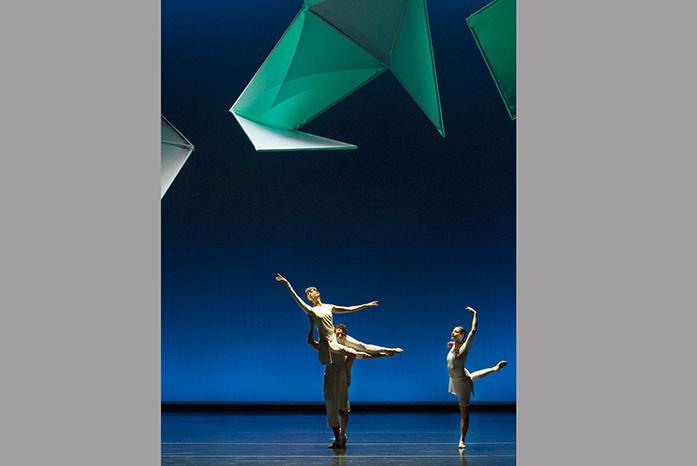By Brett Shaw
Dances are fleeting things. They come to life for a few minutes at a time on stages, in rehearsal halls, or on sidewalks, and then go on to exist only in the audience’s memory. Architecture, however, stands for years.
When choreographer Jessica Lang and architect Steven Holl bring these art forms together on the stage in their experimental production Tesseracts of Time, they navigate the opportunities and confines present in both.
Jessica Lang Dance, a touring company dedicated to showcasing the seminal artist’s work, will perform five original pieces at Hancher at 8 p.m. today.
Lang is an award-winning choreographer who has created more than 95 works with dance companies worldwide. With a Joyce Theater Artist Residency, Lang gained the resources to launch her own company in 2011. Jessica Lang Dance has now performed across the world on such prestigious stages as the Kennedy Center, in Washington, D.C., and Jacob’s Pillow Dance Festival in Massachusetts.
Hancher program coordinator Jacob Yarrow first saw Lang’s work at a festival in St. Louis and has since followed her accomplishments and activities leading to this Hancher performance.
“I’m impressed by the musicality in her choreography as well as her striking images,” he said.
However, Yarrow’s true inspiration for presenting Lang’s work at Hancher were the unique collaborative aspects and local connections present in her piece Tesseracts of Time.
Lang created the work alongside Steven Holl, the architect who designed both of the University of Iowa’s beloved art buildings. Now, Iowa City is set to be graced with yet another of Holl’s architectural masterpieces, this time through dance.
“It is a great honor to have our collaboration with choreographer Jessica Lang presented in Iowa City, on a campus where we have been dedicated to realizing two of our most important architectural works,” Holl said. “Dance, the most ephemeral of the arts, joins architecture, the most permanent of the arts — what a unique joy for our collaboration and a personal joy for an architect dedicated to the synthesis of the arts.”
Tesseracts of Time pulls elements from dance and architecture for a unique and immersive experience. Architectural structures on stage are complemented by the movement and shapes created by the performers.
Based on Holl’s ideas about the relationship between architecture and the ground, the piece is divided into four sections: Under, In, On, Over.
“It’s like the seasons of creation, how we develop, how we just keep going around in circles,” Lang said. “How we start over, finish, start over, finish, and everything that comes between that.”
The accessibility and size of the architecture in the performance was thoroughly considered. Large, heavy, intricate pieces cannot affordably tour for years across the world. Instead, Tesseracts of Time, which débuted at the inaugural Chicago Architecture Biennial in 2015, uses compactable, lightweight props on stage.
“The success of the piece is in the re-performance of it — it’s not just in the première,” Lang said. “There’s no investment in the art if it cannot be seen.”
In addition to physical pieces on stage, architectural structures are video-projected on screen with dancers both in the video and in front of the screen. The two groups perform together across dimensions in a cohesive and stimulating number as the live dancers appear to move within the screen.
“The projection was a great way that we could take some of [Holl’s] more complex ideas and offer diversity in the spaces he developed without having to build them in the space,” Lang said.
Lang, and, perhaps more surprisingly, Holl, are strongly inspired by music in their lines of work, which is strongly reflected in the piece. Holl has even conducted research developing the relationship between sound and architecture.
“Music, like architecture, is an immersive experience; it surrounds you,” Holl writes on his program website. “One can turn away from a painting or a work of sculpture, while music and architecture engulf the body in space.”
“Steven and I talked about geometric potential in sound that inspires his work, and I then chose music that had that tension so that everything we saw had a relationship to architecture,” Lang said.
Costuming and lighting play a significant role in Tesseracts of Time along with all of Lang’s pieces.
“These are elements that I have to have in my dance, so why not make them as central to the piece as the movement,” Lang said. “My teachers taught me that everything in the space has to belong, or else it doesn’t belong, and therefore I take that to the greatest sense.”
One piece that will be featured on Saturday, “The Calling,” includes a beautiful, flowing white gown with a train that consumes the stage. A solitary dancer, confined by the weight of the dress, achingly performs in an in an emotionally evocative dance. Whether melting into the ground or drawing in the radius of the gown, the fabric forms powerful images, strategically led by each movement.
“At first, it was just that I wanted to take fabric, and spread it across the stage, and make something beautiful,” Lang said. “But then the concept came to me when the director of Juilliard passed away, and I received a letter from him after they cleaned out his office.”
When attending the director’s tribute, Lang choreographed the entire dance with her husband in only an hour. She described it as “a completely visceral response.”
Lang regularly draws inspiration for her dance through emotionally significant experiences. In “Thousand Yard Stare,” Lang interviewed various veterans and therapists who work with vets to inspire a dance depicting the mental hardships of war.
“People tell me stories that become movement,” she said. “I have an emotional reaction to something, and I can physicalize that emotion through gesture and shape through the body.”



